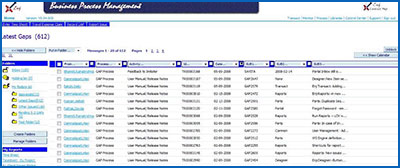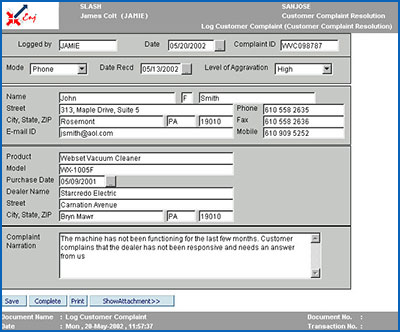Enj Transact
Transact is the hidden middleware that puts the process, document and data interchange definitions together and orchestrates the process seamlessly from end to end.
As soon as the process and interface definitions are complete, the business is ready to go 'live' with the deployment. Enj Transact is the deployment module that has two key functionalities:
b) Messaging Manager
Messaging Manager, at the back end, takes care of routing the documents as well as generating notification messages that inform users of documents that are awaiting their attention.
The Messaging Manager works all along in the background ensuring that messages are delivered to Inboxes of users that they have received documents for their attention. This is especially important because all Enj data is server housed and does not move to client side. The user actually refers to only the message which has a built in link to generate the document on the fly.
Users can instruct Messaging Manager to deliver documents immediately or at a prespecified time in the future. This allows reminders to be set for activities that need to be performed in future and also helps in keeping Inboxes uncluttered. A normal e-mail box is a single delivery point for all current information for a normal businessperson. Enj has been configured leveraging this principle. All users (unless disabled through the personalization module) receive notifications of documents received through email.
These notifications tell something about the document (as defined) and provide an interface for the user to bring up the document thus substantially reducing navigation and monitoring effort. Users can rely on the messaging manager to take care of all their notifications, concentrating on business and decisions that require their full attention.The Messaging Manager works all along in the background ensuring that messages are delivered to Inboxes of users that they have received documents for their attention. This is especially important because all Enj data is server housed and does not move to client side. The user actually refers to only the message which has a built in link to generate the document on the fly.
Users can instruct Messaging Manager to deliver documents immediately or at a prespecified time in the future. This allows reminders to be set for activities that need to be performed in future and also helps in keeping Inboxes uncluttered. A normal e-mail box is a single delivery point for all current information for a normal businessperson. Enj has been configured leveraging this principle. All users (unless disabled through the personalization module) receive notifications of documents received through email.
These notifications tell something about the document (as defined) and provide an interface for the user to bring up the document thus substantially reducing navigation and monitoring effort. Users can rely on the messaging manager to take care of all their notifications, concentrating on business and decisions that require their full attention.
Messaging Manager

As soon as the process and interface definitions are complete, the business is ready to go 'live' with the deployment. Enj Transact is the deployment module that has two key functionalities:
• Document Manager
• Messaging Manager
a) Document Manager
Document Manager manages all the documents that users deal with.
The Inbox is normally the default log in screen, bringing up all the documents that need users' attention. Documents can be sorted, filtered and segregated. Users can create folders and manager their documents through these folders. The entire look and feel is quite like a standard email application that most users are familiar with. However, unlike in an email box, one cannot delete a document!
Besides the Inbox, the Document Manager has two more facets. One is the initial screen that allows users to initiate transactions for those processes where they have such rights. Timed initiates can also be started manually through this screen. Users can set shortcut links for initiating documents that are regularly required. They are conveniently placed on all Enj screens so that the navigation is considerably reduced.
The third facet of the Document Manager is the collation screen that allows one to collate transactions if so defined in the process. Thus, daily reports can be selected and collated into a monthly report, individual scores can be collated into a class score and many other such applications.
Document Manager

• Messaging Manager
a) Document Manager
Document Manager manages all the documents that users deal with.
The Inbox is normally the default log in screen, bringing up all the documents that need users' attention. Documents can be sorted, filtered and segregated. Users can create folders and manager their documents through these folders. The entire look and feel is quite like a standard email application that most users are familiar with. However, unlike in an email box, one cannot delete a document!
Besides the Inbox, the Document Manager has two more facets. One is the initial screen that allows users to initiate transactions for those processes where they have such rights. Timed initiates can also be started manually through this screen. Users can set shortcut links for initiating documents that are regularly required. They are conveniently placed on all Enj screens so that the navigation is considerably reduced.
The third facet of the Document Manager is the collation screen that allows one to collate transactions if so defined in the process. Thus, daily reports can be selected and collated into a monthly report, individual scores can be collated into a class score and many other such applications.
Document Manager

b) Messaging Manager
Messaging Manager, at the back end, takes care of routing the documents as well as generating notification messages that inform users of documents that are awaiting their attention.
The Messaging Manager works all along in the background ensuring that messages are delivered to Inboxes of users that they have received documents for their attention. This is especially important because all Enj data is server housed and does not move to client side. The user actually refers to only the message which has a built in link to generate the document on the fly.
Users can instruct Messaging Manager to deliver documents immediately or at a prespecified time in the future. This allows reminders to be set for activities that need to be performed in future and also helps in keeping Inboxes uncluttered. A normal e-mail box is a single delivery point for all current information for a normal businessperson. Enj has been configured leveraging this principle. All users (unless disabled through the personalization module) receive notifications of documents received through email.
These notifications tell something about the document (as defined) and provide an interface for the user to bring up the document thus substantially reducing navigation and monitoring effort. Users can rely on the messaging manager to take care of all their notifications, concentrating on business and decisions that require their full attention.The Messaging Manager works all along in the background ensuring that messages are delivered to Inboxes of users that they have received documents for their attention. This is especially important because all Enj data is server housed and does not move to client side. The user actually refers to only the message which has a built in link to generate the document on the fly.
Users can instruct Messaging Manager to deliver documents immediately or at a prespecified time in the future. This allows reminders to be set for activities that need to be performed in future and also helps in keeping Inboxes uncluttered. A normal e-mail box is a single delivery point for all current information for a normal businessperson. Enj has been configured leveraging this principle. All users (unless disabled through the personalization module) receive notifications of documents received through email.
These notifications tell something about the document (as defined) and provide an interface for the user to bring up the document thus substantially reducing navigation and monitoring effort. Users can rely on the messaging manager to take care of all their notifications, concentrating on business and decisions that require their full attention.
Messaging Manager

